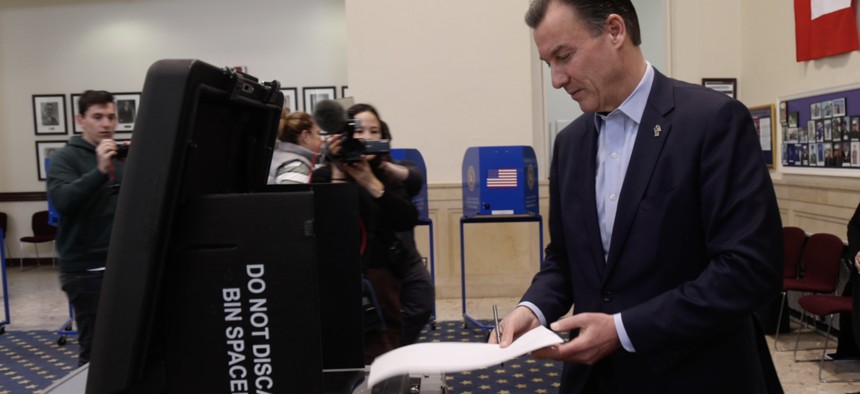2024 New York congressional battleground
Snow forecast complicates Tom Suozzi and Mazi Pilip’s Election Day
Turning out voters in bad weather will be a key factor in Tuesday’s contest in the 3rd Congressional District.

Former Rep. Tom Suozzi voted early in the special election race for the 3rd Congressional District. Howard Schnapp/Newsday RM via Getty Images
After a whirlwind month, voters are headed to the polls on an unexpectedly snowy Tuesday to determine who will replace the disgraced ex-Rep. George Santos in New York’s 3rd Congressional District. With over half a foot of snow possible – the most snow downstate has gotten in two years – the weather forecast throws a last-minute complication into what has so far proven to be a tight and contentious race.
The polls close on Tuesday at 9 p.m. as Democratic Tom Suozzi and Republican candidate Mazi Melesa Pilip make their last pitches to voters in the suburban district on Long Island. Suozzi, a moderate former member of Congress who gave up his seat to unsuccessfully run for governor, has been ubiquitous in the district over the past several weeks. He has benefited from lots of fundraising, national Democratic attention and outside spending, painting himself as a bipartisan dealmaker with decades of political experience to achieve suburban priorities like repealing a cap on state and local tax deductions. Pilip, a second-term Nassau County legislator, has run heavily on immigration issues and benefits from headwinds that have strongly favored Republicans in the county the past few years despite her lack of public appearances compared to Suozzi.
The pair faced off in their first and only debate last week, which highlighted Pilip’s struggles to clearly express her positions amid needling from Suozzi.
Two polls released less than a week before Election Day showed Suozzi slightly ahead of Pilip, but the lead still fell within the margin of error in each poll. With such a close race, any unexpected occurrence could wind up having an enormous impact on the outcome.
Case in point: Tuesday’s incoming snowstorm. Bad weather on Election Day usually depresses turnout, and the forecast originally called for rain and minor snow accumulation. Between Sunday night and Monday morning, that forecast worsened, with meteorologists predicting 5-8 inches of snow.
That might spell bad news for Republicans, who generally vote on Election Day in larger numbers than during early voting compared to Democrats. “Tomorrow’s weather will undoubtedly inhibit day-of turnout,” Republican consultant William F. B. O’Reilly said. “The Pilip campaign will have to find a way to overcome that. But if anyone can pull it off, it’s the Nassau GOP machine. Tomorrow will require literal boots on the ground.”
At a rally for Pilip the night before the election, Nassau County Executive Bruce Blakeman promised that the snow won’t cause major Election Day hiccups. “The roads will be clear and you will be able to exercise your right to vote here in Nassau County,” Blakeman, whose job includes making sure the roads get plowed, told the energized crowd of supporters. “And it is not only your right, it is your patriotic duty to get out and vote.”
Democrats go into Election Day with an early voting and mail-in voting edge. About 12,000 more registered Democrats voted during the nine-day early voting or returned absentee and early mail-in ballots compared to registered Republicans and Conservative Party members, according to Nassau Democratic Party Chair Jay Jacobs. He said the cushion is good to have, and expressed confidence in Election Day turnout once the snow stops in the afternoon. “I feel good about it,” he said in a text message.
But those early voting numbers also included a significant number of unaffiliated voters, a demographic that has broken for Republicans in recent years. About 13,000 independents voted during the early voting period, compared to roughly 30,000 Democrats and 23,000 Republicans/Conservatives, according to numbers provided by Jacobs. That makes the early voting numbers harder to determine, and a clear beneficiary of poor weather harder to predict. “Like everything else in this campaign, it’s probably a tossup,” Lawrence Levy, executive dean of the National Center for Suburban Studies at Hofstra University, said in a text message. He noted that the party with the better early voting numbers may feel confident, but noted that “the party with the stronger organization and the most energy on the biggest issue” – Republicans – may be better equipped to weather the literal storm.
In a winter special election, the kind of race that doesn’t draw large crowds, the outcome could very well come down to the ability of the party to motivate their base to turn out. Republicans have traditionally done that much better, especially in Nassau County, where the local machine’s ground operation has helped catapult its candidates in nearly every major and minor office. To combat this, Democrats have raised far more than Republicans. In January, Suozzi raised over $4.5 million, a number that may have increased since the end of the previous reporting period on Jan. 24. His campaign has spent $2.3 million during that period. That’s more than the $1.3 million Pilip raised in total. A day before the election, an outside analysis by AdImpact found that Democrats had spent $13.5 million on ads, compared to $7.9 million by Republicans. Those figures include both spending by the candidates and outside groups.
The snow isn’t the only last-minute complication that may impact the outcome of the election. New York Republicans had a rough week leading up to the special. Despite controlling the House, suburban members from the state failed to get a repeal of the SALT deduction cap to the floor for a vote. Democrats also quickly blamed House Republicans for not getting behind a bipartisan border deal negotiated in the U.S. Senate. Gov. Kathy Hochul last week said House Republicans “just signed a suicide pact” by rejecting the Senate deal.

